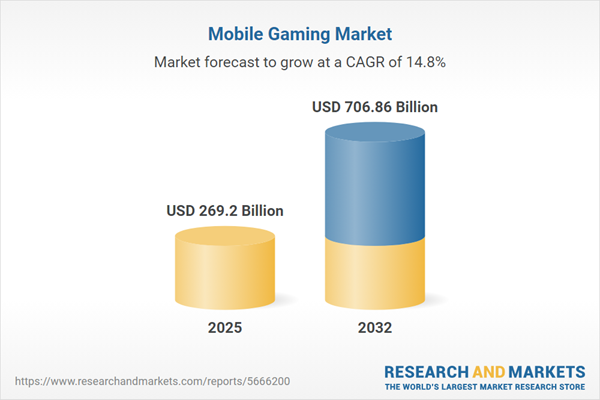Speak directly to the analyst to clarify any post sales queries you may have.
The mobile gaming market is rapidly reshaping the global interactive entertainment landscape, offering new opportunities for growth, revenue diversification, and long-term consumer engagement across regions and demographics.
Market Snapshot: Mobile Gaming Market Growth and Outlook
The Mobile Gaming Market grew from USD 234.10 billion in 2024 to USD 269.20 billion in 2025. It is expected to continue growing at a CAGR of 14.81%, reaching USD 706.86 billion by 2032. This expansion is powered by global adoption of smartphones and tablets, integration of advanced wireless networks, cloud streaming services, and a surge of consumer demand for immersive and social gaming experiences. These dynamics are making mobile gaming a leading component within digital leisure and entertainment ecosystems.
Scope & Segmentation
This report provides comprehensive coverage and analysis across all primary value-chain segments and regions, alongside the latest technology developments relevant to mobile gaming. Industry leaders, investors, and strategists will gain actionable insights into evolving monetization, platform, and user experience models.
- Monetization Models: Ad Supported, Freemium, Premium, Subscription
- Genres: Action, Casual, Puzzle, Role Playing, Simulation, Sports, Strategy
- Platforms: Android, iOS
- Distribution Channels: App Store, Google Play, Third Party
- Device Types: Smartphone, Tablet
- Player Demographics: Age groups—18-24, 25-34, 35-44, 45+; Genders—Female, Male, Non-Binary
- Regions: Americas (including United States, Canada, Mexico, Brazil, Argentina, Chile, Colombia, Peru), Europe, Middle East & Africa (with markets such as UK, Germany, France, Russia, Italy, Spain, Netherlands, Sweden, Poland, Switzerland, UAE, Saudi Arabia, Qatar, Turkey, Israel, South Africa, Nigeria, Egypt, Kenya), Asia-Pacific (China, India, Japan, Australia, South Korea, Indonesia, Thailand, Malaysia, Singapore, Taiwan)
- Key Players Analyzed: Tencent Holdings Limited, NetEase Inc., Sea Limited, Activision Blizzard Inc., Netmarble Corp., Electronic Arts Inc., Sony Group Corporation, Playtika Holding Corp., GungHo Online Entertainment Inc., Zynga Inc.
Key Takeaways: Strategic Insights for Mobile Gaming Stakeholders
- Continual advances in device performance, cloud infrastructure, and connectivity are enabling immersive, high-fidelity gaming experiences once exclusive to consoles or PCs.
- Real-time social integration, multiplayer modes, and user-generated content are central to long-term player retention and monetization strategies.
- Artificial intelligence and machine learning are driving personalized recommendations and dynamic engagement, increasing both user satisfaction and transaction potential.
- Inclusive design and broad demographic adoption, including an uptick in non-binary representation, are prompting industry players to reframe product and community strategies for wider appeal.
- Cross-platform play and partnerships with mobile network providers are streamlining experiences, reducing latency, and opening new markets for innovative titles and gameplay formats.
Tariff Impact on Mobile Gaming Supply Chains
United States tariffs introduced in 2025 have raised costs on key manufacturing components, prompting mobile device makers to reassess global sourcing and inventory strategies. Companies are turning to nearshore production and direct supplier negotiations to stabilize pricing while managing supply chain risks. This shift is also fueling investment in regional assembly hubs, designed to curb logistical delays and regionalize production in response to ongoing policy and trade uncertainties.
Methodology & Data Sources
This report adopts a mixed-methods approach: structured executive interviews, expert consultations, and primary research are complemented by a review of academic, industry, and corporate disclosures. Data is triangulated and validated using thematic analysis and scenario modeling, ensuring accuracy and actionable intelligence for decision-makers.
Why This Report Matters
- Informs portfolio and investment decisions with deep coverage across major revenue models, player segments, and key technology platforms.
- Equips executive teams to anticipate emerging risks from tariffs, regulation, supply chain shifts, and evolving consumer demands.
- Enables organizations to optimize monetization and operational efficiency through strategic recommendations targeting both mature and growth markets.
Conclusion
The mobile gaming market is evolving rapidly, reshaped by breakthrough technologies, shifting demographics, and competitive innovation. Leaders who act on these insights will be positioned for sustained growth, adaptability, and engagement within this dynamic arena.
Additional Product Information:
- Purchase of this report includes 1 year online access with quarterly updates.
- This report can be updated on request. Please contact our Customer Experience team using the Ask a Question widget on our website.
Table of Contents
3. Executive Summary
4. Market Overview
7. Cumulative Impact of Artificial Intelligence 2025
Companies Mentioned
The companies profiled in this Mobile Gaming market report include:- Tencent Holdings Limited
- NetEase, Inc.
- Sea Limited
- Activision Blizzard, Inc.
- Netmarble Corp.
- Electronic Arts Inc.
- Sony Group Corporation
- Playtika Holding Corp.
- GungHo Online Entertainment, Inc.
- Zynga Inc.
Table Information
| Report Attribute | Details |
|---|---|
| No. of Pages | 187 |
| Published | October 2025 |
| Forecast Period | 2025 - 2032 |
| Estimated Market Value ( USD | $ 269.2 Billion |
| Forecasted Market Value ( USD | $ 706.86 Billion |
| Compound Annual Growth Rate | 14.8% |
| Regions Covered | Global |
| No. of Companies Mentioned | 11 |









